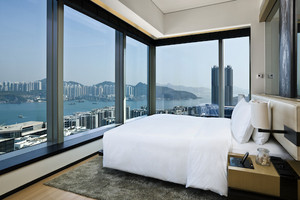
In our increasingly modern world, travelling has become a means of getting from "A" to "B", with little or no appreciation for the experience of the journey itself. As Joanna Hall discovers, the Eastern & Oriental Express has changed all that.
My first memory of a significant train ride dates back to early childhood: a summer day-trip to the then-quaint English coastal town of Brighton. Looking back it was far from exotic, but through a child’s eyes the experience of travelling by train had a definite sense of mystery and romance. There’s something special about the clicketty-clack of wheels on steel, the rhythmic motion, and being able to watch a seemingly endless landscape slip past outside a moving window.
I’ve travelled on many of trains since then, some glamorous, some less so, but one which has topped my "essential" list for a long time is the Eastern & Oriental Express. Like its legendary sister, the Venice Simplon Orient Express, the E&O is part of a new concept taking rail travel to new levels; an alluring fusion of luxury travel, and the nostalgia many people feel for trains. In a high-tech world, it’s also a simpler and more sanely-paced way of getting from one destination to another.
With tradition firmly in mind, we’ve chosen the three-day, two-night northbound route from Singapore to Bangkok, a journey which harks back to the days when train travel was king in Southeast Asia. It connects two of the region’s most remarkable cities, with a landscape in between blessed with intense natural beauty and wide open spaces, meandering rivers, and dense jungle which remains largely untouched.
On a sultry morning at Keppel Road Station, our first glimpse of the elegant dark green and cream E&O transports us back in time. It hails from an era when people chose their luggage for beauty, when hats were an integral part of an outfit, and when ladies and gentlemen dressed for dinner. It’s also an era when the mode of transport was the centrepiece of any journey.
Our home for the next 1,943 kilometres is an elegant state compartment. Surprisingly spacious, it’s fully air conditioned with an en-suite shower, and has a large picture window so you don’t miss a second of the action outside. By day, the space is configured for relaxation; one of the two beds converts into a large, comfortable armchair, while the other converts into a long sofa. And the decor is traditional, quiet and calming, rich in mahogany and cherry wood panelling with inlaid designs by local artists.
The train leaves sharp at 11 am, and meanders through the outer suburbs of Singapore. Before long, we’re crossing the Straits of Johor on to the Malaysian mainland, and the backdrop of super-modern skyscrapers and multilane highways gives way to more traditional countryside. Initially the landscape is flat; tiny villages are scattered along the railway line amid clusters of tall grasses and flowering trees, and the pace of life is undeniably slow. Children play and wave at the train as it passes, women wash clothes, and old men sit outside their homes chatting and smoking.
With mobile phones switched off, we quickly melt into the genteel life onboard. After a leisurely lunch, we head for the rear of the train and the open platform at the back of the Observation Car. The air is thick and humid, but it’s the place to truly appreciate the scale of the tropical panorama. The scenery continually changes; first there are regimented rows of rubber trees with their silvery bark and feathery leaves, then the hills appear to edge closer to the tracks and are dotted with banana trees, oil and coconut palms.
As I watch, my thoughts are drawn to the cultural diversity of this unique part of the world. Like Singapore, Malaysia is also a multicultural society. Just as its landscape changes from south to north, from cosmopolitan Kuala Lumpur to the white beaches of Penang and the rolling hills of the Cameron Highlands, each region has unique characteristics and ethnic groups adding their individual colour and flavour. Then there’s Thailand, arguably the most exotic country in Asia, possessing a diverse climate and a geography of contrasts which flows from high mountains in the north to the jungle in the south.
But the differences extend beyond landscape, language, culture and cuisine. Although the Asian approach to health and wellbeing is united in a prevailing holistic approach, subtle differences exist among these Southeast Asian neighbours. While Singapore draws upon the exotic influences from many surrounding Asian cultures - Chinese, Indian, Malay, Japanese and Thai, Thailand possesses a healing legacy all of its own. The differences range from use of traditional Thai massage, one of the four healing methods in Thai medicine, to the mineral rich mud and fragrant herbs used in body wraps, and body scrubs comprising rice meal and honey.
While Malay traditional medicine is also influenced by China and India, there are elements which set its approach apart from the others. A traditional Malay massage uses long, kneading strokes that focus on muscles, and is enhanced by spicy oils which blend turmeric, cinnamon, garlic citronella and onion to invigorate. A herbal wrap may include galangal, lemon grass and camphor, and candlenut is an ingredient used in Malay cuisine and as a scrub for the body. And there are subtle differences among the four main regions too. In the cool and lush Cameron Highlands, for example, significant emphasis is placed on the healing properties of tea - both inside and outside the body.
Thoughts of tea eventually draw us into another E&O tradition - afternoon tea. Taken in your own compartment, it’s a relief to escape the unyielding heat, and watch the scenery from the cool tranquility of our private, air-conditioned space. Later, as the train begins the steep climb skyward to the Cameron Highlands, we’ll uphold another colonial tradition; cocktails and conversation with fellow passengers in the glamorous Bar Car, and then dinner, a highlight of the journey and a dressy affair fusing silver service with gourmet Eurasian cuisine.
The next morning, we’re up at sunrise for the surreal experience of crossing the expansive Bukit Merah Lake. Today’s highlight is a stop at Butterworth Station for an excursion to the spice island of Penang. Our transport changes to a fleet of trishaws, for a tour of the historic capital of Georgetown.
A chequered history of British, Malaysian and Chinese influence has left a colourful mark on the city. Deftly dodging traffic, we pass temples, mosques, clan houses, and bustling market streets, and the whitewashed, elegant Eastern and Oriental Hotel which is a relic of the region’s colonial days.
Later, as the train crosses the border into Thailand, the landscape continues to metamorphose. Where there was equatorial jungle and mosque minarets, now there is subtropical forest and the curved peaks of pagodas piercing the tops of the trees.
On the last morning we arrive at Kanchanaburi, which is famous for being the home of the ‘bridge over the River Kwai’. The bridge was first constructed in 1942, when the Japanese army decided to build a 415-kilometre railway linking Burma and Thailand, later dubbed the ‘death railway’. The excursion begins with a leisurely cruise along the river, giving a snapshot into Thai river life, and culminates at the Thailand-Burma Railway Centre and cemetery, the final resting place for many POWs.
As the E&O snakes down from the limestone hills towards Bangkok, the lush landscape finally gives way to an urban sprawl. Clusters of shacks line the railway tracks, and people go about their business as they would the world over. Only feet away from the train, food sizzles on stalls, washing flaps in the hot wind, and people sit and chat.
Arriving in sultry Bangkok is always a surreal experience, but our journey isn’t over just yet. To ease our way gently into the Thai capital’s frenetic pace, we’re spending a few days at the Oriental Bangkok - an oasis of serenity located on the scenic bank of the Chao Phraya River.
As our taxi navigates the steamy streets of this vibrant city, my thoughts can’t help but remain with the E&O. Agatha Christie, who penned the famous novel, Murder On The Orient Express, once said: “Trains are wonderful. To travel by train is to see nature and human beings, towns churches and rivers. In fact, it is to see life.” I have to agree.
In our increasingly modern world, the art of travelling has been relegated to a means of getting from one place to another, with little or no appreciation of the journey itself. But as long as the E&O continues to transport nostalgic travellers like me through southeast Asia, the mystery, romance and tradition of train travel will continue to seduce and endure.
We're here to offer you holiday competitions and other free stuff to win as the only competition magazine in Australia. Our free competitions will also feature as Facebook competitions and we'll also provide you with travel guides and travel advice as a hotel advisor and we'll be reviewing spa day packages, food and gourmet reviews, reviews of cruises and check out spa day hotels. Keep checking back for our regular travel reviews for first-hand accounts and photography from some great destinations, hotels, cruises and airlines, along with our reviews on must-have travel accessories.
About the Eastern & Orient Express:
This luxury train was first built in Japan in 1972, and operated as the Silver Star train in New Zealand. Eventually it was redesigned and refurbished, drawing inspiration from the East, and made its inaugural journey as the new Eastern & Oriental Express in September 1993.
The train has three types of accommodations and carries a maximum of 132 passengers. They include 36 Pullman compartments, 28 State compartments, and two Presidential Suites, all featuring en-suite facilities including a toilet. Other compartment facilities include 24-hour steward service, a personal safe and a hairdryer with selected toiletries. The train also features two restaurant cars, observation and bar cars, and a boutique.
The atmosphere on board is one of relaxed refinement with smart, casual clothing appropriate during the day. In the evenings, however, men are required to wear a minimum of a jacket and tie, and dressing up in formal wear is strongly encouraged.
The fare includes all meals, including afternoon tea, and complimentary tea and coffee. For more information and pricing on the Eastern and Oriental Express train and routes, visit www.orient-express.com.
Pre and Post Train Stopovers:
Singapore:
The Oriental, Singapore, is located at 5 Raffles Avenue, Marina Square, Singapore. Voted among the "Top Hotels In Asia, 2006" in Condé Nast Traveler's Readers' Choice Awards, the hotel has recently been refurbished. Elegant and contemporary, it has 527 rooms and suites boasting spectacular views and the latest technology. Other features include a number of acclaimed restaurants, one of the city's best spas, and sports facilities including tennis courts. Call +65 6338 0066, or visit www.mandarinoriental.com.
Bangkok:
The Oriental, Bangkok, is located at 48 Oriental Avenue, Bangkok. An oasis of serenity located on the scenic banks of the Chao Phraya River, this legendary hotel has been hosting royalty, dignitaries and distinguished travellers for amost 130 years. It has beautifully appointed rooms and suites in three very different "wings" of the property, a full-service spa in a class of its own, and nine dining venues. Other unique features inclue a Thai cooking school and culture program. Call +66 2 659 9000, or visit www.mandarinoriental.com.
Tourism Information:
Tourism Authority of Thailand: www.thailand.net.au
Singapore Tourism Board Worldwide: www.visitsingapore.com
For the latest exchange rate on the Euro, visit our partners at XE.com
- By:
- Joanna Hall





















